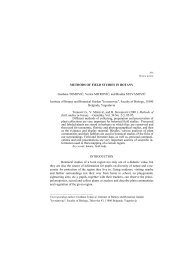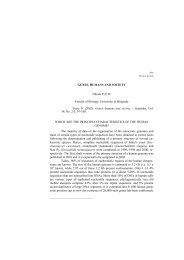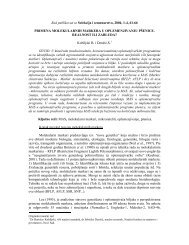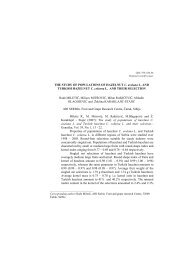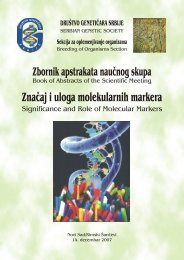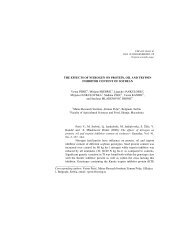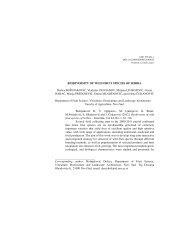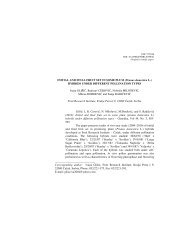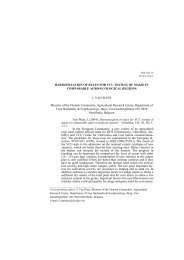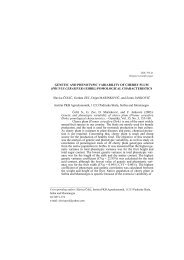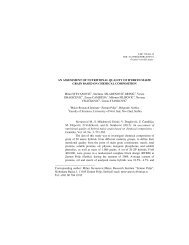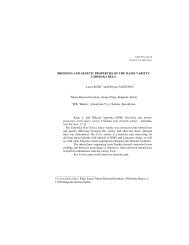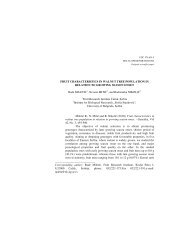Zbornik - Društvo genetičara Srbije
Zbornik - Društvo genetičara Srbije
Zbornik - Društvo genetičara Srbije
You also want an ePaper? Increase the reach of your titles
YUMPU automatically turns print PDFs into web optimized ePapers that Google loves.
I-Pos-12 ZBORNIK ABSTRAKATA III KONGRESA GENETIÈARA SRBIJE 33<br />
Subotica, 30. novembar - 4. decembar 2004.<br />
MOLEKULARNA KARAKTERIZACIJA BAKTERIJA<br />
MLEÈNE KISELINE (BMK) IZ KOZIJEG SIRA<br />
Milica Nikoliæ, Amarela Terziæ-Vidojeviæ, B. Jovèiæ, Lj. Topisiroviæ i Nataša Goliæ<br />
Institut za molekularnu genetiku i genetièko inenjerstvo, Beograd<br />
Klasiène metode za identifikaciju i determinaciju mikroorganizama, zasnovane na<br />
kultivaciji i biohemijskim metodama, nisu uvek bile pogodne za dobijanje informacija o<br />
mikrobiološkom sastavu razlièitih uzoraka. Analiza mikroflore klasiènim metodama je<br />
ogranièena na mikroorganizme koji se lako kultivišu, tako da se ne dobija informacija o<br />
kompletnoj populaciji iz uzorka. U ovom radu su korišæene molekularne tehnike kojima<br />
je moguæe okarakterisati razlièite bakteije mleène kiseline (BMK) iz kozijeg sira. Totalna<br />
DNK iz sira je izolovana i korišæena za PCR reakciju, gde su kao prajmeri korišæeni<br />
U968-GC i L1401, komplementarni V6 i V8 regionima eubakterijske 16s rDNK. Sintetisani<br />
DNK fragmenati velièine 450 bp predstavljaju zbir umnoenih DNK fragmenata<br />
koji su poreklom od razlièitih vrsta bakterija iz sira. Fragmenti su uklonirani u plazmid<br />
pUCEry19, a ligacionom smešom je transformisan soj E. coli DH5. Transformanti su<br />
analizirani na prisustvo plazmida sa ukloniranim PCR fragmentom. U daljem radu biæe<br />
uraðena DGGE analiza kloniranih fragmenata. Fingerprint tehnikom, kao što je DGGE,<br />
se utvrðuje genetièki diverzitet mikroflore sira. Meðusobno razlièiti fragmenti æe biti<br />
sekvenciirani u cilju precizne identifikacije mikroorganizama prisutnih u siru. Dobijeni<br />
rezultati biæe poreðeni sa rezultatima klasiène mikrobiološke analize.<br />
MOLECULAR CHARACTERIZATION OF LACTIC ACID<br />
BACTERIA IN THE GOAT CHEESE<br />
Conventional methods for the identification and determination of microorganisms, based<br />
on cultivation and biochemical methods, usually were suitable enough for getting the information<br />
about the composition of the microorganisms present in variable environmental<br />
samples. However, the analysis of microflora by conventional methods is limited to<br />
easy cultivable microorganisms and does not give the information about the complete<br />
population in the sample. In this study molecular techniques were used to characterize<br />
different lactic acid bacteria (LAB) from a goat cheese. The first step was the isolation of<br />
total DNA from the cheese that has been used as a template for PCR reaction. PCR, by<br />
using primers U968-GC and L1401 complementary to the V6 and V8 region of<br />
eubacterial 16s rDNA was performed. Obtained DNA products of 450 bp represent the<br />
sum of amplified DNA fragments originated from different species of bacteria from the<br />
cheese. These fragments were cloned into a plasmid pUCEry19, and ligation mixture was<br />
transformed into a competent E. coli strain DH5. Transformants were screened for the<br />
presence of plasmids containing cloned PCR fragments. The aim of further research will<br />
be the DGGE analysis of the cloned fragments. DGGE, as a fingerprinting technique is<br />
suitable to describe the genetic diversity of the cheese composition. Different fragments<br />
will be sequenced and the obtained data would be used for the identification of the microorganisms<br />
present in the goat cheese. These results will be compared with results obtained<br />
by classical microbiological methods.



